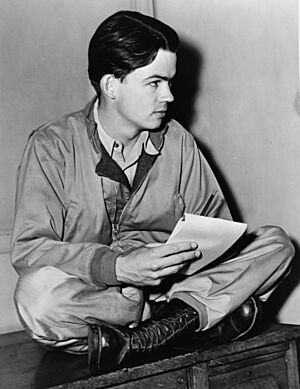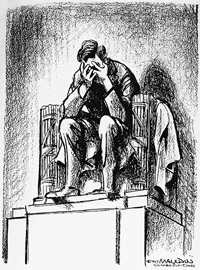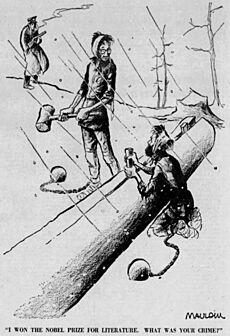Bill Mauldin facts for kids
Quick facts for kids
Bill Mauldin
|
|
|---|---|

Mauldin in 1945
|
|
| Born |
William Henry Mauldin
October 29, 1921 Mountain Park, New Mexico, U.S.
|
| Died | January 22, 2003 (aged 81) |
| Resting place | Arlington National Cemetery |
| Education | Chicago Academy of Fine Arts |
| Spouse(s) |
Norma Jean Humphries
(m. 1942; div. 1946)Natalie Sarah Evans
(m. 1947; died 1971)Christine Lund
(m. 1972) |
| Military service | |
| Branch | United States Army |
| Rank | Technician Third Grade |
| Unit |
|
| Battles | |
| Awards |
|
William Henry Mauldin (born October 29, 1921 – died January 22, 2003) was an American editorial cartoonist. He won two Pulitzer Prizes for his amazing work. He was most famous for his World War II cartoons. These drawings showed American soldiers, especially two characters named Willie and Joe. They were tired but brave infantry soldiers who faced the tough parts of war. His cartoons were loved by soldiers in Europe and by people back home in the United States.
Contents
Early Life and Artistic Beginnings
Bill Mauldin was born in Mountain Park, New Mexico. His family had a history of serving in the military. As a young man, Bill moved to Phoenix, Arizona in 1937. He went to Phoenix Union High School and started drawing cartoons for the school newspaper.
In 1939, Bill took classes at the Chicago Academy of Fine Arts. There, he learned more about drawing political cartoons.
Drawing for Soldiers in World War II
In 1940, Mauldin joined the Arizona National Guard. His military unit, the 45th Infantry Division, soon became part of the U.S. Army. While serving, Mauldin started drawing cartoons for his unit's newspaper. He drew about the daily lives of regular soldiers.
Introducing Willie and Joe
He created two cartoon characters, Willie and Joe. These two infantrymen showed what the average American soldier, or "GI," experienced. They became very popular.
In 1943, Mauldin continued his cartoon work during the invasion of Sicily and the Italian campaign. He started working for Stars and Stripes, a newspaper for American soldiers. He traveled around the front lines in his own jeep to gather ideas. He drew six cartoons every week.
His cartoons were seen by soldiers all over Europe during World War II. They were also published in the United States. The military leaders supported his cartoons. They showed the difficult side of war, which helped people understand that victory would not be easy.
Facing Challenges and Earning Respect
Not everyone liked Mauldin's cartoons. Some officers were offended because his drawings often made fun of strict army rules. For example, one cartoon made fun of General George Patton's rule that all soldiers must be clean-shaven, even in combat. General Patton called Mauldin "unpatriotic" and threatened to stop Stars and Stripes from being distributed.
However, General Dwight Eisenhower, who was Patton's boss, told Patton to leave Mauldin alone. Eisenhower believed the cartoons helped soldiers deal with their frustrations. He said, "Stars and Stripes is the soldiers' paper, and we won't interfere."
Mauldin's cartoons made him a hero to the common soldier. Many GIs said his cartoons helped them get through the war. His credibility grew when he was wounded in the shoulder by a German mortar in 1943. By the end of the war, he received the Legion of Merit award for his cartoons.
Life After the War
In 1945, at just 23 years old, Mauldin won his first Pulitzer Prize. This was for all his amazing wartime cartoons. One famous cartoon showed exhausted soldiers in the rain. Its caption joked about a typical headline: "Fresh, spirited American troops, flushed with victory, are bringing in thousands of hungry, ragged, battle-weary prisoners."
His book, Up Front, which combined his cartoons with his thoughts on war, became a best-seller in 1945. His character Willie even appeared on the cover of Time magazine.
New Directions in Cartooning
After the war, Mauldin started drawing political cartoons. These cartoons often shared ideas about civil libertarian views, which focus on individual rights. However, these cartoons were not always popular with newspaper editors.
He also tried to show Willie and Joe in civilian life, but it wasn't as successful. In the 1950s, he appeared as an actor in a few films, including The Red Badge of Courage.
In 1956, he ran for United States Congress as a Democrat but did not win.
In 1959, Mauldin won his second Pulitzer Prize. This was for a cartoon he drew while working at the St. Louis Post-Dispatch. The cartoon showed a Soviet author, Boris Pasternak, in a prison camp, asking another prisoner, "I won the Nobel Prize for literature. What was your crime?" Pasternak had won the Nobel Prize but was not allowed to accept it. The next year, Mauldin won the National Cartoonist Society Award.
Mauldin also worked as a freelance writer and illustrator. He drew for magazines like Life and The Saturday Evening Post. He sometimes brought back Joe as a war correspondent, writing letters to Willie back home.

In 1962, Mauldin moved to the Chicago Sun-Times. One of his most famous post-war cartoons was published in 1963. It was drawn after the assassination of President John F. Kennedy. The cartoon showed the statue of Abraham Lincoln at the Lincoln Memorial with his head in his hands, looking sad.
In 1985, Mauldin won the Walter Cronkite Award for Excellence in Journalism. He stayed with the Sun-Times until he retired in 1991. In 2001, he was given the honorary rank of first sergeant by the U.S. Army.
Death and Legacy
Bill Mauldin passed away on January 22, 2003, due to health issues, including Alzheimer's disease. He was buried in Arlington National Cemetery. He was survived by seven children.
His legacy lives on in many ways. On March 31, 2010, the United States Post Office released a postage stamp in Mauldin's honor. It showed him with his famous characters, Willie & Joe. In 2000, Mauldin was inducted into the Oklahoma Military Hall of Fame. He was also inducted into the Oklahoma Cartoonists Hall of Fame in 2005.
Museum Holdings
- The 45th Infantry Division Museum in Oklahoma City, Oklahoma, has a large collection of Mauldin's cartoons.
- The Pritzker Military Museum & Library also has many of his cartoons.
Peanuts Tribute
From 1969 to 1998, the famous cartoonist Charles M. Schulz paid tribute to Bill Mauldin in his Peanuts comic strip. Every Veterans Day, Snoopy, dressed as an army veteran, would visit Mauldin's house. They would share "root beers and tell war stories." Schulz drew 17 such visits. In a 1998 strip, Schulz even included Willie and Joe themselves.
Filmography
The films Up Front (1951) and Back at the Front (1952) were based on Mauldin's Willie and Joe characters. However, Mauldin was not happy with how they turned out. He felt they were too much like slapstick comedies.
Mauldin also appeared as an actor in the 1951 films The Red Badge of Courage and Teresa. He also appeared as himself in documentaries like America in the '40s and The World at War.




